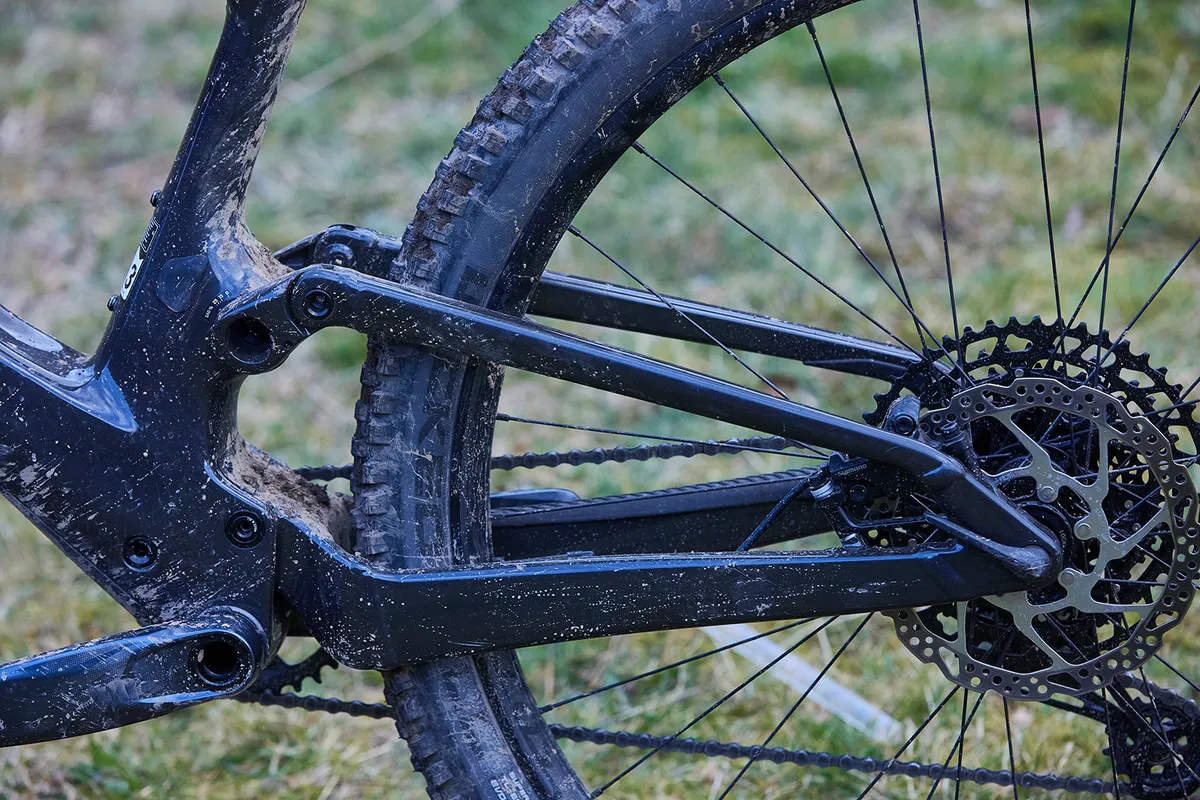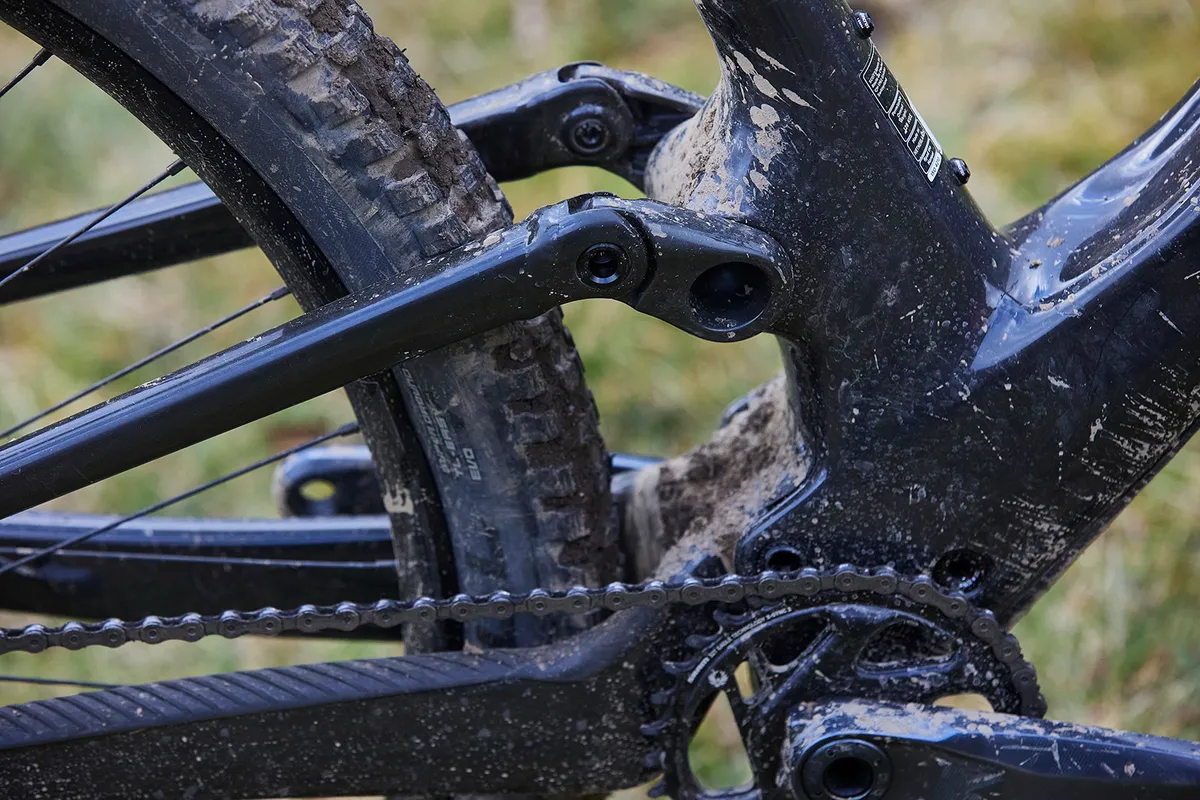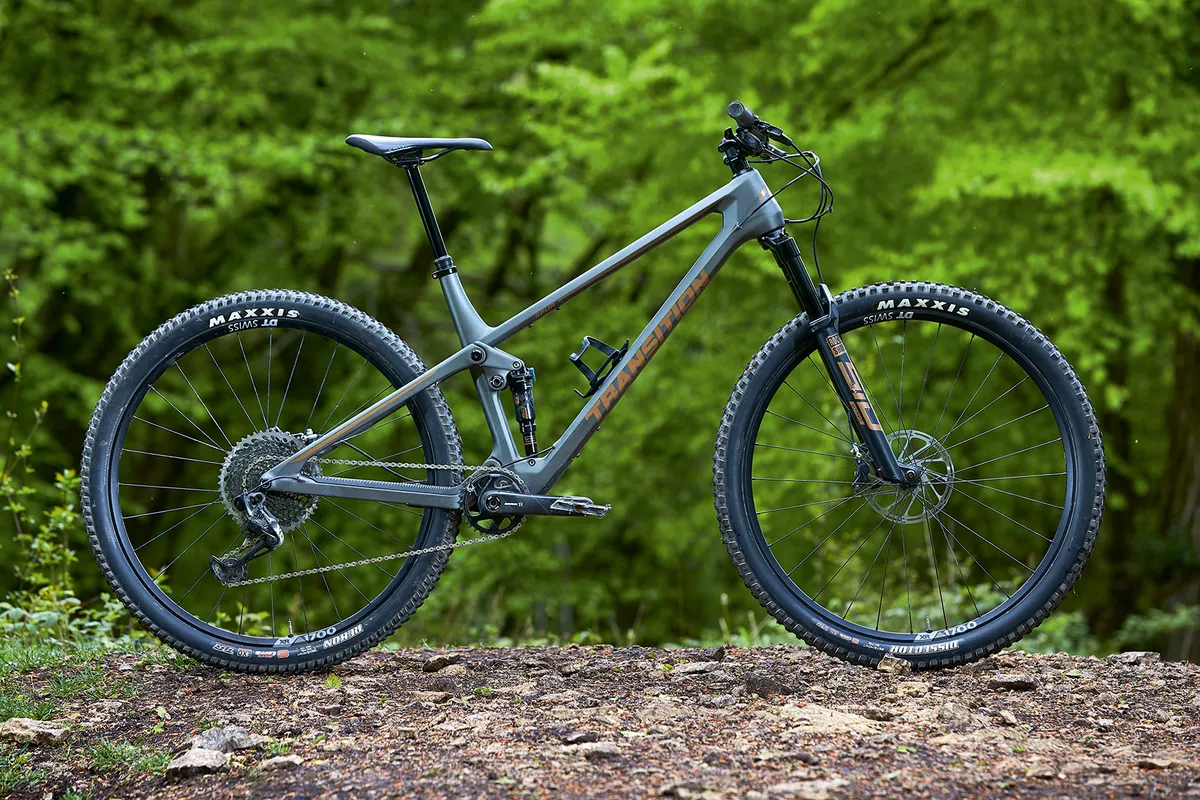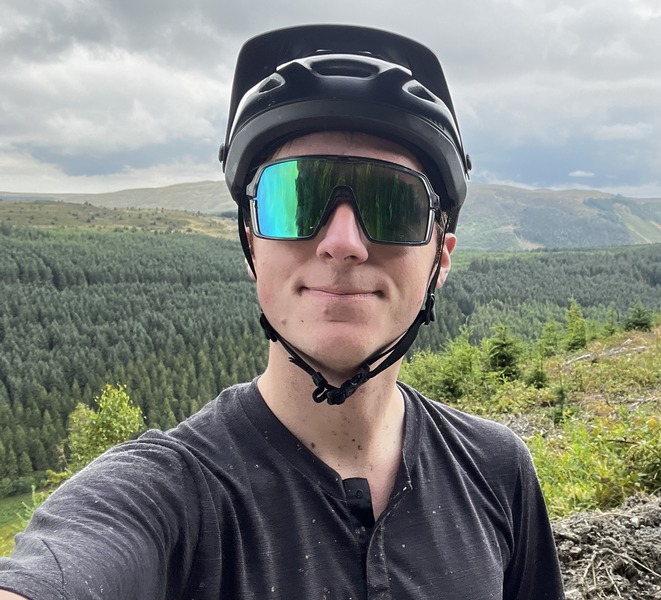The Spark 940 sits in the middle of Scott’s lighter-weight trail bike family and features its incredibly neat hidden-shock design. It’s the first Scott bike to use this approach, though it has since been rolled out to the longer-travel Genius.
The shock is hidden inside the front triangle, and it gives the bike an incredibly clean look.
All bikes in the Spark family share the same frame design, with the Spark RC bikes getting 120mm of travel front and rear, while the 900 series bikes get longer 130mm forks and dropper posts on all models.
They also all use Scott’s TwinLoc remote system to control the suspension settings on the fly.
The Spark 940 is the cheapest in the range to use Scott’s second-tier HMF carbon front triangle.
Regardless of model then, you’re getting the same proven pedigree that's taken Nino Schurter to glory on many occasions.
Scott Spark 940 frame and suspension

The 940 model sits in the middle of the range of Spark trail bikes, and as such features Scott's HMF carbon front triangle, paired with an alloy rear triangle.
This saves cost, but adds a little extra weight compared to the full-carbon frames used higher up in the range.
The rear triangle uses flex built into the seatstays, rather than a heavier, more maintenance-intensive pivot. Scott reckons this approach is best for shorter-travel, fast trail bikes and enables it to tune the kinematics as desired.
The seatstays push on a rocker linkage that's partially visible on the outside, but connects internally to the top of the shock.
It pivots around a large-diameter bearing that's there to improve stiffness and reliability.

The shock is mounted internally in the frame, where it's isolated from trail debris and water.
While this means the shock’s seals will stay cleaner for longer, and thus feel smoother, you should still adhere to the recommended service intervals.
In order to access the shock for adjustments, a tool-free, quick-release door that doubles as the down tube protector is located at the base of the down tube. Through this, you can inflate and adjust the shock settings as desired.
To the chagrin of many, the gear and dropper post cables, as well as the rear brake hose, run through the headset for cleaner lines. This makes it more awkward when it comes to maintenance.
There are two pairs of bottle cage mounts in the frame, ideal for longer rides. Meanwhile, the rear axle has a removable tool, featuring T25, 4mm and 6mm hex heads, making wheel removal for puncture repairs or transport easier.
Scott Spark 940 geometry

Sharing a frame with the race-focused Spark RC, the 940’s geometry is modern without being overly radical, reflecting the goal to create an agile, fast-feeling all-rounder rather than a short-travel, enduro-style shred sled.
The reach on the size large is a fairly conservative 470mm and the head angle sits at 65.8 degrees. This should add an element of high-speed stability without the bike feeling lazy in slower-speed situations.
The headset enables you to steepen the head angle by 0.6 degrees by turning it through 180 degrees.

This enables you to sharpen up the steering feel if you want the geometry to more closely mirror the Spark RC's. The bike was left largely in the slacker setting for testing.
The chainstays are a moderate 437.5mm in length, while the bottom bracket sits a hefty 43.5mm below the axles in a bid to boost cornering stability.
At 76.4 degrees, the seat tube is reasonably steep, but the tube itself is longer than I’d like. My size-large test bike has a 490mm seat tube, limiting the ability to run a dropper post much longer than the 150mm Syncros Duncan fitted as standard.
| | S | M | L | XL |
|---|---|---|---|---|
| Seat angle (degrees) | 75.7 | 75.9 | 76.4 | 76.7 |
| Head angle (degrees) | 65.8 | 65.8 | 65.8 | 65.8 |
| Chainstay (mm) | 437.5 | 437.5 | 437.5 | 437.5 |
| Top tube (mm) | 561 | 589 | 613 | 641 |
| Head tube (mm) | 90 | 90 | 105 | 115 |
| Trail (mm) | 107 | 107 | 107 | 107 |
| Bottom bracket drop (mm) | 43.5 | 43.5 | 43.5 | 43.5 |
| Bottom bracket height (mm) | 331.5 | 331.5 | 331.5 | 331.5 |
| Wheelbase (mm) | 1,145 | 1,174 | 1,205 | 1,236 |
| Standover (mm) | 759 | 767 | 778 | 801 |
| Stack (mm) | 607.5 | 607.5 | 617.7 | 627 |
| Reach (mm) | 410 | 440 | 470 | 500 |
Scott Spark 940 specifications

The main point of difference between the Spark and its rivals is Scott’s TwinLoc system.
This uses a remote lever on the handlebar to control the three compression settings (Lockout, Trail and Descend) on the custom-built fork and shock.
In the Lockout setting, the fork and shock have the compression circuits closed off, giving a much firmer and more efficient pedalling feel for smoother climbs.
Switch to the Trail setting and the shock's air spring is constricted. This limits suspension travel and keeps the bike riding higher in the travel, as well as increasing compression damping to give a firmer ride.

In Descend, both fork and shock are left fully open, with maximum air volume too for the most grip, travel and comfort out on the trail. The shock can still be tinkered with using volume spacers, though.
The handle-bar remote has two levers to control these settings, with a single click in either direction to toggle through the modes, or a full sweep to go from Descent to Lockout or vice versa in one movement.
A third lever sits under this to control the dropper post.

The shock and fork on the 940 are custom built for the Spark by RockShox and comprise a Deluxe Select RL3 shock and a Pike RL3 fork to deliver 120mm and 130mm of travel respectively.
Driving you forward is a mixed drivetrain from SRAM, comprising parts from its SX, NX and non-series X1 stables. Shimano provides the two-piston MT501 brakes with 180mm resin-pad only rotors.
Scott’s Syncros house brand provides the bulk of the finishing kit, including the rims and dropper post.
Schwalbe’s Wicked Will tyres in the mid-weight Super Ground casing and SpeedGrip compound provide the grip.
Scott Spark 940 ride impressions

I tested the Spark 940 around the trail centres and natural trails of North Wales and the Midlands, giving the bike plenty of rocks, rolls, berms, hardpack and good old-fashioned UK winter mud to sink its tyres into.
Getting the bike ready for testing was straightforward, with it being simple to get the suspension set up, despite the shock being hidden inside the frame.
The removable down tube door makes accessing the shock's air and rebound adjustments easy. The integrated sag dial on the linkage and frame makes it easier to set up than a lot of its rivals.
A small removable rubber cover also makes it relatively simple to check if you’re using full travel or access the upper shock mount bolt.
What’s less simple is the cable management thanks to the headset cable routing. Not only that, but the proprietary stem spacers also make bar-height adjustment awkward because you’ll need to cut the steerer tube down if you want the bar to go lower than stock.
Once you do, there’s no way to get it higher again.

The SRAM drivetrain is also a little disappointing given the price of the bike, especially compared to direct-buy rivals from Canyon and others.
The gear range of the 11-50t cassette was perfectly adequate, but the SX shifter and cassette feel very cheap on a bike costing this much.
I’d much rather see a cheaper crankset than the X1 fitted if it meant a better-quality shifter could be specified in its place.
Scott Spark 940 climbing performance

Given the Spark 940 can trace its origins to the world of cross-country racing, it's no wonder it's an effective climber. It takes some work to unlock its full potential, though.
On smoother climbs, the Rockshox Deluxe bobs a fair amount, even with a fairly conservative 25 per cent sag, and the Spark relies on the middle Trail setting of the TwinLoc system to feel as efficient as I would expect from this kind of bike.
It certainly doesn’t invite hard, out-of-the-saddle efforts as much as I’d like, and I felt I was forced into a more rearward position when seated.
The flip side to this is the bike has excellent traction on looser climbs, with the rear wheel really digging in and extracting maximum grip from the lightly treaded Wicked Will rear tyre.
Given the often wet and muddy conditions on the trail, it impressed me with just how many technical climbs I was able to clean with minimal fuss or tyre slip.

The tyres also roll very well on harder surfaces, so you can make quick progress once up to speed.
When the Trail setting of the shock was engaged, the bike felt much livelier, with only a slight loss of that tractor-esque tenacity on looser surfaces.
It was very proficient on rolling traverses when I wanted some suppleness in the suspension to maintain comfort and traction but still needed a solid dose of ruthless efficiency.
Trail mode was so effective I rarely felt the need to use the Lockout setting, despite having easy access to it from the TwinLoc remote.
Scott Spark 940 descending performance

All is not rosy with the same TwinLoc remote on the way back down though.
Though the suspension levers are easy to reach, I found the dropper post anything but easy, with a stiff actuation and awkward location that was a real hindrance when I wanted to drop the saddle in a hurry.
The situation was only made worse when the suspension was in the Trail setting. Both levers were in very close proximity to each other and I was left trying to feel which lever I was pushing.
It’s not all that intuitive and definitely something that could be improved on.

Outside of that, though, the Spark is a very fun and capable descender that's held back by a couple of spec choices.
The frame's geometry is very well balanced, with the 470mm reach, mid-length chainstays and slack head angle giving the bike plenty of stability while retaining a good dose of agility.
It feels great once airborne too, giving me the confidence to send some bigger jumps and drops than I would usually feel comfortable with on similar bikes.
The RockShox Pike fork gives the front end of the bike a muscular feel and offers excellent control on rough terrain, while the rear suspension feels well balanced with the fork too, despite sporting 10mm less travel.
While the alloy rear triangle doesn’t feel quite as stiff as the stiff carbon front end, the Spark holds a line well until the Schwalbe Wicked Will front tyre breaks traction, which it often did a lot sooner than I’d like.

The minimal tread, with small side knobs and hard SpeedGrip compound, really robbed the bike of front-end grip. It felt like a constant fight to keep it from washing out as soon as there was a hint of moisture on the trail.
Another spec choice that undermines confidence and control is the two-piston Shimano MT501 brakes and their resin-pad only rotors.
These seriously lack power and, combined with the tyres' lack of bite, meant steeper trails had to be entered with a large degree of caution.
A grippier front tyre, such as Schwalbe’s Nobby Nic, or even Magic Mary, along with more powerful four-piston brakes and better rotors would be a much better fit given how capable the rest of the bike feels on descents.
How does the Scott Spark 940 compare to the Transition Spur?

A bike I’m very familiar with is the Transition Spur. On paper, the bikes are very similar, with angles and measurements that are within a degree and a few millimetres of each other and even share the same basic linkage actuated single-pivot design.
On the trail though, they feel very different.
The Spur has a more planted feel, and feels more forgiving, with a lovely, damped feel to the frame. The Spark is not a harsh bike by any means, but back to back, it felt a little edgier and gave a touch more feedback through my hands and feet.
The Spur also feels more efficient when left open and far less reliant on the shock's compression lever on climbs, while giving away little in the traction stakes.
The Spark felt poppier and more at home on jump-filled trails; the Spur feels as though it wants to squash any jumps or drops and the Spark just goaded me on to send it as far as my skills allowed.
The base-level Deore build of the Spur is more expensive. However, the better specification and user-friendly features such as a threaded bottom bracket and less-finicky cable routing, make it a very tempting proposition.
Scott Spark 940 bottom line

While certain aspects of the spec and performance of the Spark held it back, it's still a thoroughly enjoyable bike to ride and, on the right trail, is an absolute hoot.
With a grippier front tyre and better brakes, you could really unlock its descending potential.
Given I rarely felt the need for the Lockout setting of the shock, a two-position grip-shift style remote for the suspension – along the lines of RockShox TwistLoc – would be a great fit and would make using the dropper remote easier to boot.
If you want a fun-loving bike with a very good frame, that can be a fast and capable all-rounder (if you’re willing to put the work in and change a few bits and pieces over time), the Scott Spark 940 could be right up your street.
Product
| Brand | scott |
| Price | 6100.00 AUD,4299.00 EUR,4299.00 GBP,4400.00 USD |
| Weight | 13.2400, KILOGRAM (L) - without pedals |
Features
| Fork | RockShox Pike RL3 Air Custom Charger 3-Mode Dampe, 130mm travel |
| br_stem | Syncros DC 2.0 |
| br_chain | SRAM NX |
| br_frame | Spark Carbon HMF Mainframe with Alloy 6011 Swingarm, 120mm travel |
| Tyres | Schwalbe Wicked Will 29x2.4" EVO Super Ground, TLE, 67EPI, Addix Speed Grip f/r |
| br_brakes | Shimano SLX MT510, 180/180mm rotors |
| br_cranks | SRAM X1, 32t |
| br_saddle | Syncros Tofino 2.5 Regular |
| br_wheels | Syncros X-30SE rims on Formula CL-811 f, Formula CL-148S r hubs |
| br_headset | Adjustable head angle Syncros Cable Integration System |
| br_shifter | SRAM NX |
| br_cassette | SRAM SX 11-50 |
| br_seatpost | Syncros Duncan Dropper Post 2.5 31.6mm, S & M size 125mm, L size 150mm, XL size 170mm |
| br_gripsTape | Syncros |
| br_handlebar | Syncros Fraser 2.0 DC Alloy, 760mm |
| br_rearShock | RockShox Deluxe Select RL3 |
| br_bottomBracket | SRAM DUB PF92 |
| br_availableSizes | S, M, L, XL |
| br_rearDerailleur | SRAM NX |
